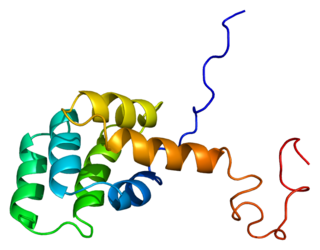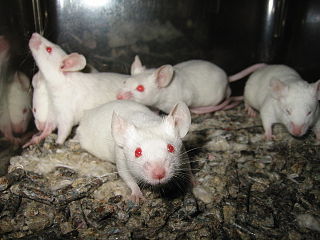Related Research Articles

The laboratory mouse or lab mouse is a small mammal of the order Rodentia which is bred and used for scientific research or feeders for certain pets. Laboratory mice are usually of the species Mus musculus. They are the most commonly used mammalian research model and are used for research in genetics, physiology, psychology, medicine and other scientific disciplines. Mice belong to the Euarchontoglires clade, which includes humans. This close relationship, the associated high homology with humans, their ease of maintenance and handling, and their high reproduction rate, make mice particularly suitable models for human-oriented research. The laboratory mouse genome has been sequenced and many mouse genes have human homologues. Lab mice sold at pet stores for snake food can also be kept as pets.

MHC class I molecules are one of two primary classes of major histocompatibility complex (MHC) molecules and are found on the cell surface of all nucleated cells in the bodies of vertebrates. They also occur on platelets, but not on red blood cells. Their function is to display peptide fragments of proteins from within the cell to cytotoxic T cells; this will trigger an immediate response from the immune system against a particular non-self antigen displayed with the help of an MHC class I protein. Because MHC class I molecules present peptides derived from cytosolic proteins, the pathway of MHC class I presentation is often called cytosolic or endogenous pathway.

FOXP3, also known as scurfin, is a protein involved in immune system responses. A member of the FOX protein family, FOXP3 appears to function as a master regulator of the regulatory pathway in the development and function of regulatory T cells. Regulatory T cells generally turn the immune response down. In cancer, an excess of regulatory T cell activity can prevent the immune system from destroying cancer cells. In autoimmune disease, a deficiency of regulatory T cell activity can allow other autoimmune cells to attack the body's own tissues.

Interleukin 9, also known as IL-9, is a pleiotropic cytokine belonging to the group of interleukins. IL-9 is produced by variety of cells like mast cells, NKT cells, Th2, Th17, Treg, ILC2, and Th9 cells in different amounts. Among them, Th9 cells are regarded as the major CD4+ T cells that produce IL-9.

CD23, also known as Fc epsilon RII, or FcεRII, is the "low-affinity" receptor for IgE, an antibody isotype involved in allergy and resistance to parasites, and is important in regulation of IgE levels. Unlike many of the antibody receptors, CD23 is a C-type lectin. It is found on mature B cells, activated macrophages, eosinophils, follicular dendritic cells, and platelets.

CD30, also known as TNFRSF8, is a cell membrane protein of the tumor necrosis factor receptor family and a tumor marker.

3T3 cells are several cell lines of mouse embryonic fibroblasts. The original 3T3 cell line was established in 1962 by two scientists then at the Department of Pathology in the New York University School of Medicine, George Todaro and Howard Green. Todaro and Green originally obtained their 3T3 cells from Swiss albino mouse embryo tissue. After landing a principal investigator position at the National Cancer Institute in Bethesda, Maryland, Tadaro repeated the isolation procedure from the NIH Swiss mouse embryo with his students and established NIH-3T3 cell line.

Protein tyrosine phosphatase, receptor type, C also known as PTPRC is an enzyme that, in humans, is encoded by the PTPRC gene. PTPRC is also known as CD45 antigen, which was originally called leukocyte common antigen (LCA).

B-lymphocyte antigen CD20 or CD20 is expressed on the surface of all B-cells beginning at the pro-B phase and progressively increasing in concentration until maturity.

The Fas receptor, also known as Fas, FasR, apoptosis antigen 1, cluster of differentiation 95 (CD95) or tumor necrosis factor receptor superfamily member 6 (TNFRSF6), is a protein that in humans is encoded by the FAS gene. Fas was first identified using a monoclonal antibody generated by immunizing mice with the FS-7 cell line. Thus, the name Fas is derived from FS-7-associated surface antigen.

BALB/c is an albino, laboratory-bred strain of the house mouse from which a number of common substrains are derived. Now over 200 generations from New York in 1920, BALB/c mice are distributed globally, and are among the most widely used inbred strains used in animal experimentation.

B-lymphocyte antigen CD19, also known as CD19 molecule, B-Lymphocyte Surface Antigen B4, T-Cell Surface Antigen Leu-12 and CVID3 is a transmembrane protein that in humans is encoded by the gene CD19. In humans, CD19 is expressed in all B lineage cells. Contrary to some early doubts, human plasma cells do express CD19, as confirmed by others. CD19 plays two major roles in human B cells: on the one hand, it acts as an adaptor protein to recruit cytoplasmic signaling proteins to the membrane; on the other, it works within the CD19/CD21 complex to decrease the threshold for B cell receptor signaling pathways. Due to its presence on all B cells, it is a biomarker for B lymphocyte development, lymphoma diagnosis and can be utilized as a target for leukemia immunotherapies.

MYC proto-oncogene, bHLH transcription factor is a protein that in humans is encoded by the MYC gene which is a member of the myc family of transcription factors. The protein contains basic helix-loop-helix (bHLH) structural motif.

Activating transcription factor 6, also known as ATF6, is a protein that, in humans, is encoded by the ATF6 gene and is involved in the unfolded protein response.

Transcription factor Maf also known as proto-oncogene c-Maf or V-maf musculoaponeurotic fibrosarcoma oncogene homolog is a transcription factor that in humans is encoded by the MAF gene.

Sarcoplasmic/endoplasmic reticulum calcium ATPase 3 is an enzyme that in humans is encoded by the ATP2A3 gene.

DnaJ homolog subfamily B member 11 is a protein that in humans is encoded by the DNAJB11 gene.

B-cell lymphoma/leukemia 11B is a protein that in humans is encoded by the BCL11B gene.

GPI mannosyltransferase 3 is an enzyme that in humans is encoded by the PIGB gene.

Nuclear factor -like factor 3, also known as NFE2L3 or 'NRF3', is a transcription factor that in humans is encoded by the Nfe2l3 gene.
References
- ↑ Kim, KJ; Kanellopoulos-Langevin, C; Merwin, RM; Sachs, DH; Asofsky, R (1979). "Establishment and characterization of BALB/c lymphoma lines with B cell properties". Journal of Immunology. 122 (2): 549–554. doi: 10.4049/jimmunol.122.2.549 . PMID 310843.
- ↑ Priem, Dario; van Loo, Geert; Bertrand, Mathieu J. M. (2020-05-01). "A20 and Cell Death-driven Inflammation". Trends in Immunology. 41 (5): 421–435. doi:10.1016/j.it.2020.03.001. ISSN 1471-4906. PMID 32241683. S2CID 214771288.
- 1 2 "A20: Modeling B cell lymphoma in mice". drugdevelopment.labcorp.com. Retrieved 2022-12-05.
- ↑ Meziane el, K; Bhattacharyya, T; Armstrong, AC; Qian, C; Hawkins, RE; Stern, PL; Dermime, S (2004-10-10). "Use of adenoviruses encoding CD40L or IL-2 against B cell lymphoma". International Journal of Cancer. 111 (6): 910–920. doi: 10.1002/ijc.20332 . PMID 15300803.
- ↑ Siegel, S; Wagner, A; Kabelitz, D; Marget, M; Coggin J, Jr; Barsoum, A; Rohrer, J; Schmitz, N; Zeis, M (2003-12-15). "Induction of cytotoxic T-cell responses against the oncofetal antigen-immature laminin receptor for the treatment of hematologic malignancies". Blood. 102 (13): 4416–23. doi: 10.1182/blood-2003-01-0198 . PMID 12869512. S2CID 9814435.
- ↑ Siegel, S; Wagner, A; Schmitz, N; Zeis, M (2003). "Induction of antitumour immunity using survivin peptide-pulsed dendritic cells in a murine lymphoma model". British Journal of Haematology. 122 (6): 911–4. doi: 10.1046/j.1365-2141.2003.04535.x . PMID 12956760.